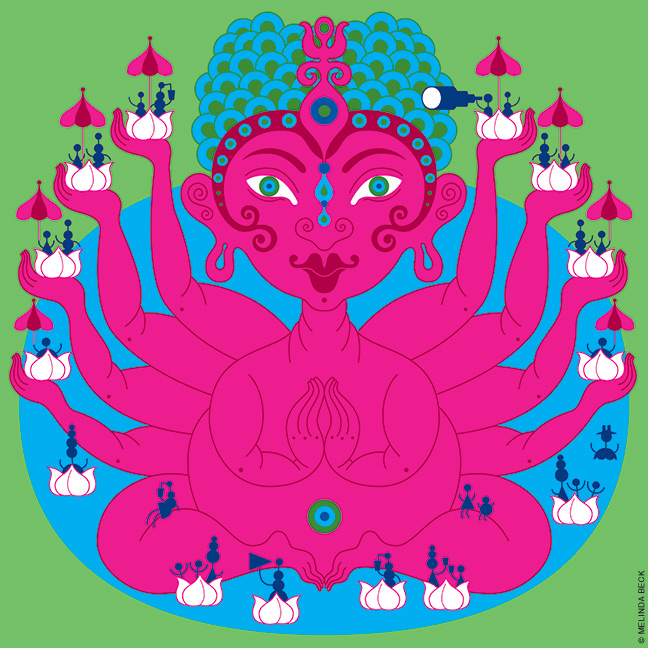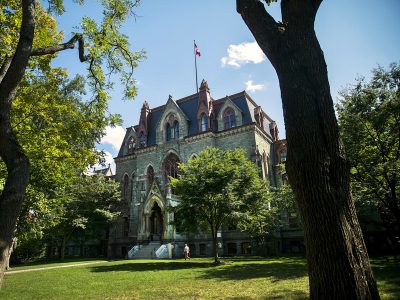
Religious studies professor Justin McDaniel explores the “really fun” side of Buddhism.
When you think about Buddhist temples, the first image that comes to mind isn’t necessarily a water slide. You probably also don’t imagine a heavy game of laser tag, or an operatic Buddha on a gigantic rotating throne. But these are quite typical in countries like Vietnam, Thailand, and Laos, says Justin McDaniel, professor of religious studies in the School of Arts and Sciences. In a January lecture for the Wolf Humanities Forum, McDaniel presented a few case studies from his latest book, Architects of Buddhist Leisure: Socially Disengaged Buddhism in Asia’s Museums, Monuments, and Amusement Parks.
“What I find really fascinating about these sites,” he said of the hundred or so Buddhist theme parks in southeast Asia, “is that they show a different way of learning how to be Buddhist.” With their massive light shows and winding roller coasters, the sites create an “atmosphere of abundance” and “a sense of distraction,” he said, which may seem to contradict the Buddhist principle of nonattachment. “But what types of distractions do we think are noble or valuable?”
McDaniel, a former Buddhist monk who created the popular Existential Despair class last year [“Gazetteer,” Mar|Apr 2018], got the idea for this research while he was translating manuscripts at the Xa Loi monastery in Saigon. In the library, McDaniel noticed he was the only person there all day. “I wanted to find out, well, if the Buddhists aren’t in the library, then where are they?” he said. The answer: “They’re over at the water park.”
Although most of the parks he studied do have temples and libraries on site, “they’re not aiming to be sacred sites”— but rather “ecumenical and entertaining sites.” Many Buddhists visit without learning more about Buddhist texts or history than they already know. “But it feels like you’re doing something right,” he said. “You’re in an atmosphere that celebrates who you are,” and parents deem it a fun way to connect kids to their heritage.
The “effervescence” of Buddhist teachings can still be seen all around, whether it’s in the multilingual museum placards or in the various and sundry liturgies coming through the park’s loudspeakers. “In a sense, you learn how to be [Buddhist] over time.”
Thailand’s 235-acre Ancient City is dubbed the world’s largest outdoor museum—reminiscent of Colonial Williamsburg, but much, much bigger. Constructed in 1963 by Lek Viriyaphant and his wife, Braphai—millionaires who made their fortune from a virility elixir—it has temples from all over southeast Asia, some originals and some replicas.
“It’s laid out to be pan-cultural,” McDaniel explained. There’s a Laotian library, an entire Burmese village, a Chinese temple, Taoist shrines. Viriyaphant “bought a Malaysian Christian floating church, but he had to create a pond to put it in. So he created a pond.” He wanted to include a famous cliffside temple that overlooks Cambodia, “but he couldn’t get this temple, so he replicated it … and he had to build a mountain [to put it on].”
Viriyaphant also used his money to fund the 105-meter-high Sanctuary of Truth—“the largest wooden edifice on earth,” said McDaniel—and the Erawan Elephant Museum, named after its three-headed bronze elephant that is the largest metal statue in the world.
“There are elevators that go up the [elephant’s] legs,” McDaniel said. “There’s an entire Buddhist temple in the belly. … It’s bigger than the Statue of Liberty.” Underneath the animal is a five-story museum with the founder’s collection of spiritual art. He wanted all of the world’s religions represented as a personal bid for world peace.
In another example, Shi Fa Zhao, a monk in Singapore, “wanted to bring the Buddhist world together” with his temple based around Buddha’s tooth. (“The tooth is most likely fake,” McDaniel said.) McDaniel spent time there as a volunteer curator and said Zhao was aiming to find a universal Buddhist design.
“The wood is from Burma. The flags are from Tibet. The trees out front are from Sri Lanka.” There are golden floors from India and railings from Nepal. There are Tibetan statues and Bhutanese statues, and Chinese statues that are made by Japanese artists. In the gift shop, visitors can buy prayer wheels, coins, and amulets from a variety of spiritual traditions.
“And the funny thing is,” McDaniel said, “when I talked to [Zhao] the one question he refused to answer was what sect he was from and who his teacher was—which is the first two things most Buddhist monks and nuns will answer.”
These sites of “Buddhist spectacle culture,” as he called them, promote “ecumenicalism without an agenda.” And they are a new phenomenon in the last 100 years.
“Buddhists are pretty comfortable with diversity. They’re comfortable being fractured,” McDaniel explained, adding that there is no sacred language, no ecclesiastical structures, and no Buddhist laws.
But just because they accept each other does not mean they know each other. Most schools of Buddhism operate in silos. “Think about it. The Dalai Lama is a nominal head of one sect of Tibetan Buddhism that only numbers about one million people … More people in this room know who the Dalai Lama is than most people in monasteries in Laos and Burma.”
These attempts to educate and bring the Buddhist world together are what’s new and unusual, McDaniel said. In a typical visit to an amusement park, families may hear a Tibetan mantra and then have their photo taken with Kuan Yin, the Chinese bodhisattva of compassion. They may browse the gift shop, look at Laotian art—and then find themselves, as McDaniel did, “playing Buddhist laser tag, which is awesome.”
“It’s very, very hard, in a sense, to find out really what is the point to [these places],” he said, “besides just being really fun.” —NP




